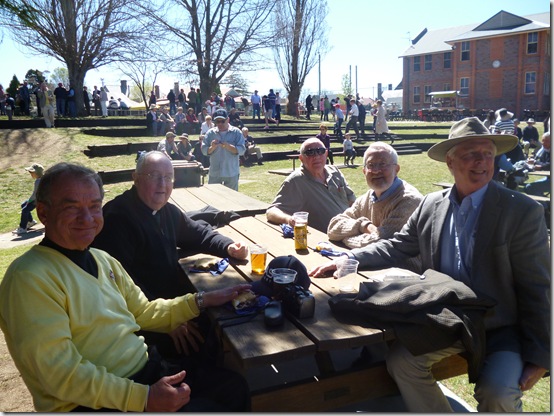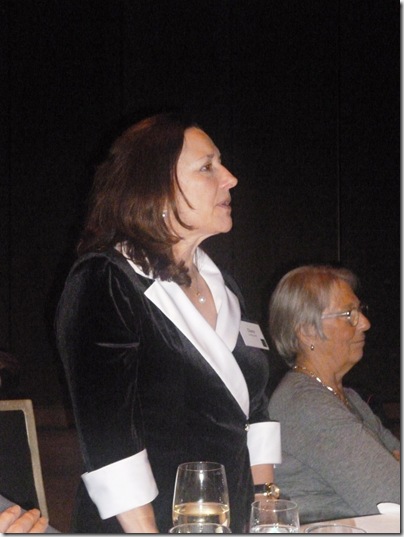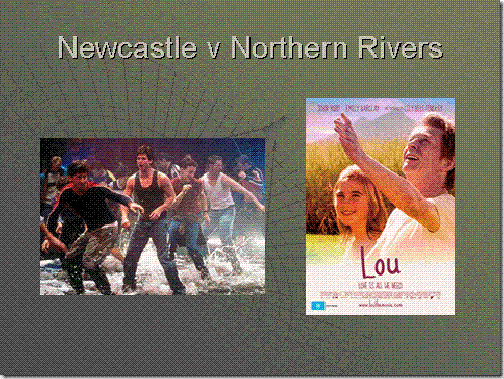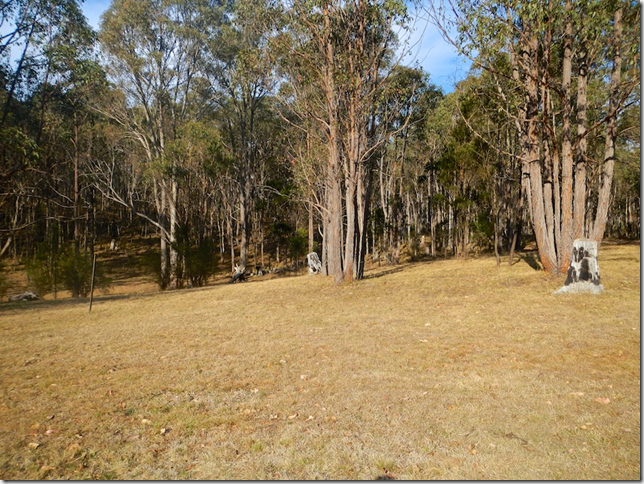In a post on my personal blog, Old boys, young boys & a bright, sunny day - TAS OBU weekend September 2012, I recorded some initial reactions on my return to TAS (The Armidale School) for a school reunion. Later, I mined the visit for a number of stories on different blogs, as well as my Armidale Express column.
As my regular readers will know, one of my annoyances is the way that so many assume that if you do not come from one of our major capital cities you are, somehow, deprived. There is a world outside the metros, and it's a vibrant and far reaching world. It's just different.
To illustrate this, Brian Harrison has given me approval to reprodu ce his speech to the Old Boys' reunion dinner. This photo is part of our group. Brian is second on the left.
ce his speech to the Old Boys' reunion dinner. This photo is part of our group. Brian is second on the left.
Just to add some background, Brian's Dad was an Armidale solicitor and a major figure in the new state movement.
Brian was an academic chap who used to really stretch me in arguments. We were also members of the same bible study group at TAS. Later at UNE, we were also history honours students and members of Isabel McBryde's pioneering Australian prehistory honours group, a group I have written about. Bryan's honours thesis was the first ever study of the Myall Creek massacre and is still quoted today.
I often speak of my fellow New England expatriates and our varying worlds and indeed try to write for them. Brian's oration will give you an introduction into one slice of a New England world now past and its continuing influence.
Reading the speech made me feel that I should later give you some context based on my own writing, for the influences linger in our history and in broader Australian and international life in ways now unseen. But, for now, I leave the final word to Brian.
"Headmaster, fellow old-boys, distinguished guests: It’s a great pleasure and privilege to be able to speak to you this evening as a rep. of all of us OBs who are back at the School this weekend, and in particular, for those of us who have now reached their‘half-century not out’ – the 50-year returnees who left TAS in 1962.
When Andrew Heap, our OBU President, asked me to do the honours at tonight’s dinner, my initial reaction was that I was scarcely the right man for the job, since, apart from subscribing to Binghi over the years, I’ve been completely out of touch, not only with the School and OB activities, but even with Australia. In fact, for 38 of these last 50 years I’ve been living abroad, In four different countries. However Andrew and a couple of others twisted my arm a bit, and made the point that having an OB speaker whose adult life has been quite international could actually be a point of interest, underlining the great diversity of life-styles and experiences that T.A.S. has nurtured. After all, diversity is the name of the game these days, in many areas of life.
So, OK, I’m not a typical OB. However, when we scratch the surface a bit, I suspect we’ll find that in fact there ain’t no such animal as a “typical TAS old boy”. He’s a mythical creature, like a unicorn or a balanced American Federal budget. I suspect one thing we’ve all been discovering this weekend as we catch up with our schoolmates from so long ago is surprise after surprise at the varied and unpredictable turns our respective lives have taken over these many years. Sometimes, looking back on our own lives, we ourselves may be just as surprised as anyone else. If anyone had predicted during my last year at TAS that I would be back here half a century later, in a clerical suit and collar as a Roman Catholic priest, I would have laughed and said he was crazy.
Just in case anyone’s curious about how I got to where I am, I was raised a Presbyterian, but during most of my time at T.A.S. I wasn’t particularly devout or religious. However, during my last year or two I began to take such matters more seriously, and our terse but eloquent School motto, “Absque Deo Nihil”, gradually ceased to be just three words in a dead language. I quietly came to an increasing conviction that, indeed, without God – and specifically, without Jesus Christ, God dwelling among us in human flesh -there is “nothing”, or at least, nothing of ultimate and eternal significance.
After leaving school, I majored in History at U.N.E. here in Armidale, and, after the intellectual adventure of facing the usual challenges to religious faith that one encounters in a secular university, I embarked on a cross-cultural adventure: I went with Australian Volunteers Abroad, to teach history for a year or two with the Lutheran Mission in the central highlands of Papua New Guinea. (The only two PNGans I had ever met before then were the first two boys from our northern neighbour ever to study at TAS, Kevin Yabara and Elijah Emori, who came to the school in 1964, when I was back here as a Duty Master in White House while studying at the Uni. I remember them as two great little kids, cheerful, fitting in well, and so adding a further positive note of racial diversity into the life of the School, along with Charlie Chim, Tan Tek Lin, and several other Asian students who will be remembered by us 1962 returnees.)
I ended up staying seven or eight years in PNG, during which time I became increasingly convinced of the truth, not just of Christianity in general, but of Roman Catholicism in particular, and joined the Catholic Church just ten years after leaving TAS. Several years later I decided to train for the priesthood, and after beginning in Melbourne and Sydney, I transferred to Rome to finish my studies, and in 1985 had the tremendous privilege of being among a group of seminarians who were ordained priests in St. Peter's Basilica by one of the outstanding world leaders of recent history, the late great Polish Pope John Paul II.
After post-graduate studies in Rome I returned to tropical climes, this time in the sunny Caribbean, lecturing in Spanish as a Theology teacher at the Pontifical Catholic University of Puerto Rico. After 18 years there my Church superiors asked me to come to the States, and for the last five years I’ve been on the banks of the great Mississippi River in the beautiful and fascinating city of St. Louis, Missouri, where at present I’m the priest in charge of one of oldest churches in that state, built by German migrants in 1843.
So that, in a nutshell, is my own personal story.What about the common story of our life at TAS that we’re recalling this weekend after half a century or more?
I think it’s appropriate, first of all, to call to mind a few of the well-known figures from our leaving class who, having passed prematurely from this life, are unfortunately not able to join us this weekend. Phil Francis succumbed to cancer a few years ago. We nicknamed him “Slow”, but he was of course anything but slow in the swimming pool, where he was quite a champ. Ross Lynn, another of our ’62 classmates, in the First XV and a genial friend to many of us, died tragically not long after leaving school. Rennie Barnes is another no longer with us.
Since some of us repeated the Leaving in ’62, we were classmates for several years with the ’61 leavers. Among them, David Black died quite young, many years ago. More recently deceased were my fellow day-boys Peter Monley and John Westmacott. John Masters passed away less than three years ago, not long after our 1961 school captain Ian “Speedy” Erratt. Particularly sad was the death several years ago of Reg Byrne, an exceptionally talented young man, intellectually and on the sports field, who somehow never fulfilled his early promise in later life. “Java” was a once-in-a-generation sporting prodigy, who debuted with our First XI at the age of 12 years and 11 months – a GPS record, it seems. He soon made the First XV as a mercurial centre three-quarter, and was an outstanding sprinter, high jumper and long-jumper who for several years was our main point-scorer at the GPS athletics.
Nor can we forget the various Masters at TAS who impacted our lives in so many ways, even if the impact sometimes descended rather sharply on our rear end. Nearly all of them, of course, have now gone to their eternal reward. But who among us will ever forget, for instance, Brian Mattingley? Old “Joe”, as we called him, wasn’t always too popular in the short run because of his role as Housemaster and as a stickler for discipline, but in hindsight he was a true Christian gentleman – a priest in his retirement years – who, by his personal example and his teaching of English and Latin did much to inculcate precision in thought and language, as well as perennial values as honour, self-discipline and service that had also been exemplified in his distinguished WWII flying record.
The same can be said of the gentle charity and quiet, firm faith with which Rev. Tom Kitley carried out his vocation as School chaplain. Likewise with the colourful and unforgettable George Crossle, who made an indelible mark wherever he was, whether refereeing a football match on Front Field, teaching History in the classroom, or at nights as Master on Duty, when miscreant boys sometimes managed to get lights switched on as fast as George could switch them off! I have it on excellent authority that one night certain individuals almost gave George apoplexy by dragging a metal bedstead along the roof of the covered way, creating a racket approaching that of a sustained machine-gun attack!
Although as a day-boy I was never around for such nocturnal special operations, I did by the same token see the more gentle and devoutly religious side of Alan Cane, who was an elder in the Presbyterian Church I attended on Sundays. In the classroom most of us will recall him as a fine but at times cantankerous maths teacher, whose frustration would periodically burst forth with comments like, “There’s two ways to do mathematics – my way and the wrong way!”, Or again, “TAS heads were made for football, not mathematics!” There were of course other masters we remember with appreciation: among others, Des Harrison, Ray Yeoman, Alan Thompson, John Traas, Peter Brownie, our football coach, still with us. And of course, there was Lennie Bell, who fought an uphill battle to sow seeds of a finer musical culture in the largely unreceptive soil of lads with ears more attuned to Elvis, Frankie Avalon, Slim Dusty and other luminaries of the Top 40 lists of the time.
And how can we fail to give a special mention the man who, over and above his history teaching, tirelessly collaborated with Len year after year in the dramatic and musical life of the school – one of the few masters from half a century ago who remains in the land of the living, and who has dedicated his whole life to the School. I refer of course to the one and only Jim Graham, whom I’ve just had the great pleasure of visiting two days ago, along with John Myrtle and Ross Lane, at his home in Macksville. Jim and all these other good men, along with others, of course, whom I haven’t been able to mention, contributed in their own way in helping us lay the foundations of our adult lives. We remember them all with deep appreciation and gratitude.
In recalling the masters who guided our formation at T.A.S. we must of course remember in a very special way the men who were at the helm of the School in our last years – two quite different headmasters. Gordon Fisher, whom all of our generation remember with respect and affection, had been the post-World War II builder and consolidator, and of course, a great promoter of rugby. In The Armidalian of December 1960, his last year as headmaster, GAF was described in a tribute written by Alan Cane as“a great humanist with a profound belief in the dignity of man.” Our own final year, 1962, was in fact a watershed year in the School’s history. For of course it was the first of a new regime in which the late Alan Cash began to lead the School in what might be called a more modernizing direction. Coming from Melbourne, he was naturally not quite so enamoured of rugby as his predecessor, and he also saw the opportuneness of extending the School’s network of contacts, support and enrolment potential to include more of Armidale’s urban cultural diversity as well as the School’s traditional rural base. (A long term effect of that new trajectory is that there now about as many day-boys at T.A.S. as boarders, whereas in our time we day-boys were only about 5% of the total.)
Our new headmaster was ably assisted in this task of PR with the Armidale community and promotion of the Arts by his very capable wife, Maris, whose passing we also lamented a couple of years ago. What a gracious, charming and gregarious lady Maris Cash was! In fact, occasionally a bit more charming and gracious than her own husband would have wished. Some of us remember the occasion when several miscreant boys had been told to wait outside the headmaster’s office to have their backsides tanned. His arrival was delayed for some reason, but meanwhile, Maris happened to come on the scene. Blissfully unaware of the dire destiny that waited these lads, she cheerfully invited them all inside the Cash residence for a cup of tea and scones while awaiting the Headmaster’s arrival! His embarrassed chagrin when he eventually came in the door to find this rather surreal scenario can readily be imagined. (Whether the boys were eventually ‘socked’ more or less severely as a result of Mrs. Cash’s untimely hospitality is something I don’t know.)
The year 1962 was remarkable in other ways. For some us here this weekend, Ted Giblin, John Myrtle, James White (now on the staff) and myself, having lead roles in Jim Graham’s production of “The Gondoliers” was a great formative experience. And in athletics – my own preferred sport – it was a truly vintage year – a real classic.
Although I wasn’t in the School’s GPS team that year, I was able to go to Sydney to watch the competition, and that afternoon at the SCG 50 years ago will always remain engraved in my memory as including the single most jubilant and exhilarating moment of my life – before or since. Rick How had gained 3rdplace in the 100 yards, as well as 2nd place in the Long Jump, and ran a great 22.4 seconds for 2nd place in the 220. The depth of our sprinting talent that year was shown by our third place in the Open relay.
However, the School’s champion of champions that afternoon was a bloke who performed even more stunningly – one of my best mates at TAS and a lifelong friend, Ross Lane, here with us tonight. He turned in what was by far the most spectacular distance run in the School’s history up to that time. In fact, I’d be surprised if it has been equalled since in all this subsequent half-century.
Ross had had only recently discovered his talent for running, and after training with Percy Cerutty, the coach of Australia’s great Olympic champion Herb Elliott, he’d been turning in some great mile performances with times in the 4:40s and 4:30s, in an era when anything under 5 minutes for the mile was considered quite good for a schoolboy. So this was the big race we were all waiting for that day at the SCG. The GPS open mile record stood at 4 minutes, 21.3 seconds, set just five years previously by H.J. Rouse of Kings.
With my heart pounding on the sidelines almost as fast as if I’d been on the track, my stopwatch went off with the starting gun, and with Ross already ahead in not much over two minutes at the half-mile mark, it was clear this race was going to be a landmark moment in the School’s sporting history. From then on he just kept increasing his lead, and had the crowd warmly clapping this unknown lad from Armidale for most of the last lap as he tore toward the tape. He finally beating the best runners all the other much bigger GPS schools could offer by an incredible 100 yards or so. I looked breathlessly at my stopwatch, and it was reading 4:21.1. Completely over the moon, I could do nothing other than jump up and own ecstatically, waving my stopwatch and yelling, “Record! Record!” to anyone and everyone within earshot. Alas, that crowning glory of a GPS record was not to be. Not quite. The official time was announced as 4:22.0 flat, just .7 secs outside the record. However, it was clear that if Ross had not run a gruelling sub-2 minute half mile earlier in the afternoon, gaining second place to a boy from Sydney High, his mile time would certainly have been well under the record, and in all probability under 4 minutes for the metric mile, the 1500 metres which has been run in the schools' competition since 1966.
So 1962, for several reasons, was a truly memorable year for TAS. And that remains true if we place that year in the wider context of world history. Right while we were swatting up hard in the last month or so before the Leaving Certificate, the Cold War between East and West reached its most acutely tense point ever in the Cuban missile crisis in October, when Kennedy and Khrushchev faced each other off perilously.
I can remember George Crossle telling us shortly afterwards that we should thank God for answering the prayers of so many people round the world: for the threat of a nuclear world war had just been narrowly been averted. In that very same month, on October 11th 1962, a very different event took place that would eventually affect very profoundly my own life’s vocation and work. In Rome that day, Pope John XXIII and over 2,000 Catholic bishops inaugurated what was probably the single most epoch-making religious event of the 20th century, the Second Vatican Council. The Catholic Church now undertook to update her disciplinary norms, forms of worship, and general policies toward the outside world. If it had not been for Vatican II, with its new emphasis on ecumenical collaboration and friendly dialogue between the Catholic Church and other denominations, instead of the old sectarian bitterness, you probably not be listening tonight to an RC priest speaking here at this Anglican school. Another indirect effect on the School of those changes set in motion in the Vatican that year is the fact that there are now quite a few Catholic boys enrolled at TAS, whereas that was something almost unheard of when we ’62 leavers were at school.
Many other things have changed greatly at the School over this half-century, as they have in our own lives and in society generally. Since our school days, when such things as the Internet, I-pads and Kindle were beyond the radar screen even of science fiction, and computers were mysterious, massive and cumbersome machines possessed only by a few big university science departments and the Pentagon, the information technology revolution has impacted all of our lives to an extent no one could have foreseen. Also, the TAS Music School and Hoskins Centre now bear witness to a greater depth and breadth of cultural interests so ably promoted at the School by recent headmasters, following the general trajectory initiated by Alan Cash. Diversity in a rather different form has also now come to TAS with the enrolment of girls in what we used to call Junior School. The link of the School to Gordonstoun in Scotland, and the international Round Square educational movement – again, largely at the initiative of Jim Graham – has been another important and valuable innovation of recent decades. It has broadened the horizons of TAS so as to give a greater place to such things as outdoor adventure in education, as well as deepening the School’s Christian character by emphasising practical service to the community, especially the underprivileged.
How, then, can we sum up those experiences of our schooldays that we’re recalling this weekend, along with the role that our years here played in shaping and directing our future lives? Here again, diversity is the keynote: each of us put something different into TAS while we here, and drew something different out, even though the very fact that we’ve come back here after all these years bears witness to a common heritage of lasting friendships and mainly positive memories. School life anywhere on earth, of course, never has been and never will be, a mere bed of roses, fallen human nature being what it is. But I think we can all agree that the inevitable tough times and rough experiences we went through at school at least had the merit of helping to make men out of us. (I’m afraid that very concept is often seen as a bit politically incorrect these days, but I think it remains valid and important for all that.) Since I can’t speak for anybody else, all I can do in conclusion is sum up my own appreciation, with fifty years’ hindsight, of the School’s contribution to my own life.
There are two features that I think together gave a unique character to the education I received here: two contrasting but complementary features that I doubt would be easily found linked together in any other school.
First, there is the rural character of TAS. It has a proud heritage of men and families on the land - we think of the many Crofts, Whites, Moffatts, Wrights, Blomfields and many other families that have been such a mainstay of the School since its foundation. These families close to the soil, cultivating the primordial fruits of the earth, spring from their forebears who were our first 19thcentury pioneer settlers. This heritage has instilled in me a sense of deeper appreciation for all that is distinctively Australian in our national character and traditions.
On the other hand, and at the same time, TAS, as the only GPS school in the country, also helped to awaken and nurture in me a lasting appreciation for values of a broader, and more universal character: the noble traditions of Western Christian civilization that have been handed down to us via our British heritage, with its imperishable values of fair play, personal honour, self-discipline and moderation, respect for individual human dignity, tolerance of others, public service under parliamentary constitutional monarchy, and the pursuit of excellence in developing one’s God-given talents. In short, TAS presented to me and fostered in many ways the ideal and vision of becoming a Christian gentleman – an Australian Christian gentleman. And that vision – which remains just as vital and relevant today as it ever did – is something we and the School can be justly proud of."


 ses were built in brick. Urban in-fill had started. Flats had begun to appear.
ses were built in brick. Urban in-fill had started. Flats had begun to appear. 


 o
o ![[Janene.JPG]](https://blogger.googleusercontent.com/img/b/R29vZ2xl/AVvXsEgfpLqYliiDhc7uBR-6evLCmKapi7lKjzaDUTCBXi6P3KPiauijS0Umo5cEQkiFNl5DcXOa3dMjdtE-qhPzHfssKose4F-2P5I91wc638vklYs-gn_4W7bAcx1qZFlyw8YvwEupdQ/s220/Janene.JPG) watched with interest as my column was set up for print. Then we used scissors and paste to set up pages. Now its so very different!
watched with interest as my column was set up for print. Then we used scissors and paste to set up pages. Now its so very different!


 or.
or.

















